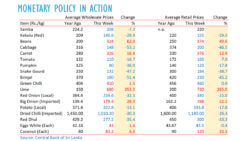ශ්රී ලංකාවේ ආහාර මිල සියයට 30 – 40 කින් බැහැලා – ECONOMYNEXT
ශ්රී ලංකාවේ ආහාර මිල ගණන් පසුගිය වසරට සාපේක්ෂව සියයට 30 -40 ප්රමාණයකින් පහත වැටී ඇති බව ECONOMYNEXT වෙබ් අඩවිය වාර්තා කොට ඇත.
භාණ්ඩ මිල සම්බන්ධ වාර්තාවක් ද ඒ සමග පළ කොට තිබේ.
ශ්රී ලංකා මහ බැංකුව අනුගමනය කළ මුල්ය ප්රතිපත්ති මෙයට හේතු වූ බව ද එම වාර්තාවේ සඳහන් ය.
ECONOMYNEXT වාර්තාව පහත පලවෙයි
Sri Lanka food prices fall 30 to 40-pct, wheat taxes hiked to keep up rice prices

Global food and other commodity prices have also been helped by the US Federal Reserve which stopped printing money from around March 2022.
Global food prices – measured in US dollars- started to fall from around May as the dollar appreciated.
Sri Lanka’s central bank hiked rates and stopped buying Treasury bills allowing them to be bought by the people instead of the central bank, driving up yields to double the policy rate.
Rates were driven up partly on fears of domestic debt restructuring, due to a flaw in the IMF’s evolving default framework where a cut off date for restructure is not set early, and market participants are expected to buy securities pending default.
Sri Lanka’s central bank by allowing market rates to go up and by halting printing of money after intervening in the forex market (sterilization of interventions) probably averted hyperinflation.
Deflationary Policy
At time rates were hiked, suppliers were already quoting prices with the validity of a few weeks or quoting in Us dollars.
RELAED Sri Lanka prevented a worse contraction, hyperinflation, with rate hike: CB Governor
The action may have stopped spontaneous dollarization of the economy, which usually follows hyperinflation or steep falls in the currency making it difficult for suppliers and retailers to mark prices and people ignore legal tender rules which inflationists enforce in less unstable times.
Index measured price rises stopped from around September 2022 as the central bank started to show balance of payments surpluses with deflationary open market operations. In March the rupee was allowed to appreciate, helping the currency peg reflect credit developments and also helping deflate prices.
Rising price indices and commodity prices are a fallout of what classical economists called inflation of money supply above the anchor (then specie) required to maintain stable price, and economic conditions.
Easy Growth Strategy
Sri Lanka started printing money from 2015 to target an output gap (trying to get ‘easy growth’ by inflating the economy with ‘easy money’ and not actual work or reforms) leading to serial currency collapses, under so-called flexible inflation targeting, critics say.
When budget deficits were cut in 2018 money was printed to target an output gap on the premise that monetary policy has to be loosened because fiscal policy is tight, analysts warned that the country will default as there was no escape from inflationism.
In 2020 taxes were cut and a record level of money was printed to target an output gap, in the worst deployment of macro-economic policy seen by the central bank in its history, leading to default and a severe fall in the rupee from 182 to 360 to the US dollar.
An analysis of central bank’s weekly data show that except for some items used as spices, green chili and lime, all other major food prices have fallen due to central bank action.
Pumpkin retail prices were down 17.8 percent to 120 rupees a kilo, Snake gourd was down 38 percent to 184 rupees, brinjals were down 45 percent to 230 rupees, cabbage was down 46 percent to 200 rupees. But beans were up 49 percent to 374 rupees and carrots were up 14 percent to 376 rupees.
Potato produced locally were down 17.8 percent to 333 rupees. Sri Lanka frequently hikes taxes on imported potatoes to keep domestic prices artificially high.
Prices of rice have also fallen.
Retail raw rice prices have fallen about 29 percent from 220 to 155 rupees, according to central bank data. At supermarkets however white raw rice is available for as low as 145 rupees a kilogram.
Sri Lanka is expecting a rice surplus in 2023 with a good main (Maha) harvest and a Yala harvest also expected despite crop damage of at least 4 percent of the planted area due to low rain in August due to late planting.
Related Sri Lanka projects rice surplus in 2023
Political Nexus
Farmers have been complaining that farmgate paddy prices are too low at around 80 to 90 rupees a kilogram. Minister of Agriculture Mahinda Amaraweera said prices have moved up some this month and wants farmgate prices above 100 rupees a kilogram.
Sri Lanka agriculture minister talks up rice, paddy price
Sri Lanka this week hiked taxes on imported wheat to reduce access to flour to give extra profits to rice farmers, who have long depended on politically-backed artificially high prices through import protection and therefore cannot export their crop.
Wheat and other commodity prices have also fallen globally after the US Fed started to stop printing money in March 2022.
